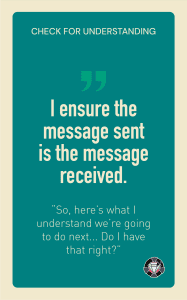Workplace Communication: Stop Asking “Do You Understand?”

Image is from freepik.com by @freepik
When your organisation or team communicates effectively, you’re nimble. You can respond to change quickly. But if your organisation doesn’t invest in effective workplace communication, you’ll face a constant series of misunderstandings that waste time, create conflict, and drag down everyone’s performance. One easy-to-use workplace communication tool will eliminate most of these frustrations, save you time, and improve performance and morale.
Stop Asking “Do You Understand?”
Every moment of communication with your team or customer is precious. Especially in hybrid, remote, or fast-moving organisations, you’ve got to make every interaction count.
But one of the worst ways to waste these precious moments is by asking, “Do you understand?”
If the person answers “yes”—well, you know nothing more than you did before you asked. They said “yes,” but what does that “yes” actually mean?
Maybe they think they understand (and whether they do or not, you don’t know). Or maybe they just told you yes because that’s what they think you expect to hear.
Perhaps they just want to move on and get to their next task, so they say “yes” hoping to leave the conversation.
Regardless of the person’s intent, when someone tells you, “yes, I understand,” you know nothing more than you did before you asked. And you rarely learn about problems in understanding until later when things go wrong.
Now, if they tell you “no, I don’t understand,” that is better in the sense that now you have new information. But you still don’t know where the confusion happened or what to do about it. And it required the person you asked to have the courage to admit they didn’t understand (which shouldn’t take courage, but often does).
Maximise Your Workplace Communication ROI: Check for Understanding
You can make the most of every conversation and eliminate hours, days, even months of frustration, headache, and heartache by shifting away from “do you understand?” Instead, ask an open-ended question that helps both of you immediately figure out how well you grasp what one another has said. We call this a “check for understanding.”

Check for Their Understanding
When you check for understanding, ask the other person what they understand (not if they understand). There are many ways you can do this. Here are a few examples:
- “Let’s check for understanding here, what are the next steps we will take?”
- “I’d like to make sure we’re on the same page. What’s happening now?”
- “What’s your understanding of our agreement?”
All of these questions are open ended – the person answering will share what they know. There is no yes/no pressure to be right. It’s about sharing their perspective so we can move forward efficiently.
As you hear them summarise in their words, you’ll know what they know and where they are missing critical information. Now you can clarify and ensure everyone has what they need.
Check for Your Understanding
When you are on the receiving end of communication from a colleague, team member, supervisor, board member, spouse, child, friend – or anyone else, you can use the check for understanding to make sure you’ve got it.
This time, you’ll repeat back what you understand and ask for clarification. For example:
- “I’m hearing that we need to move this project up to deliver this Friday and that we should postpone our work on the marketing effort until next week. Do I have that right?”
- “It sounds like we’ve agreed to add a full-time person to this team. If that’s right, I’ll talk to HR to get it posted.”
- “It seems like this task will take about five hours, is that what you had in mind?”
- “I’m hearing that competing data requests from other teams are keeping you from getting what you need to complete this on time. Is that right?”
In all these examples, you don’t allow yourself to assume you understand. You double check. Sometimes you’ll extend that check for understanding to add more clarity. For example:
- “Thanks for confirming. So, what I see happening next is that the product team will be worried. How will we communicate the change with them?”
- “Okay, so not five hours. You want a 30 minute estimation. Are you comfortable with a range then as opposed to a specific number?”
Whether you check for their understanding or yours, now everyone has the same information.
Organisational Check for Understanding
One of the most frustrating parts of life in organisations that grow beyond one level of organisation is cascading communication. We constantly hear the workplace communication frustration of senior leaders who don’t understand why everyone isn’t on the same page.
The problem usually stems from a lack of – you guessed it, checking for understanding. But there are usually two or even three checks that need to happen.
If you’re a senior leader who has information to cascade through the organisation (and it’s not passive information – people need to do something with it), you need to ensure that everyone’s got it and acts on it. Here’s how you do it:
1. Start with your direct report team.
In addition to the key message, clarify with the team that part of their responsibility is to ensure that their team understands and acts on the message. Check for understanding with your direct reports. For example, “Okay, if there aren’t any more questions, let’s check for understanding. What needs to happen next? By when?” Make sure they’ve got cascading and ensuring understanding as part of their next steps.
2. Skip-level check for understanding.
Once the cascading timeline passes, have some conversations with people who report to your team. Ask then, “What is your understanding of [topic / key message]?”
Listen to what they say. If they have it wrong, don’t chastise them. Instead, gently correct: “Oh, actually, here’s what’s happening… What questions are coming up for you?” Then you can wrap up with another check for understanding: “Just to make sure I’m communicating as clearly as I hope to, what are you hearing me say here?”
3. Coach the managers whose people don’t have it.
This is a critical step if you want a nimble, responsive, accountable organisation. You’ve got to hold your team member responsible for their team’s understanding of the message. If their team doesn’t have it, that’s your team member’s responsibility.
Check in with your team member. Let them know they had some folks struggling with the message. Check with them about how they’re communicating. How are they checking for understanding themselves? Are they? (Or are they falling back on “do you understand” and failing to learn what people actually know?)
If the manager continues to struggle, it may help to attend a meeting where they will be communicating and observe how they do it and then coach them after the meeting. This rarely takes more than once or twice before they figure it out and ensure clear communication.

Eliminate Common Workplace Communication Barriers
Once leaders learn how to check for understanding, there are four common obstacles that get in the way of clear communication.
1. Concern that it takes too long
We get it—when time is short, every second feels precious.
But the investment in clear understanding gives you back so much time later that you won’t spend cleaning up misunderstandings, re-doing work, and solving unnecessary conflict.
2. Feeling like people should be “better than this”
“These are professionals. They should get this the first time.” We hear this one quite a bit.
Frankly, it’s nonsense. Human communication is challenging at the best of times and no one gets it right every time. Heck, we teach these concepts nearly every day, and we still have frequent misunderstandings where we’ll use the same word, but interpret it differently.
One of your most critical leadership responsibilities is communication. You can’t inspire, motivate, or take a group of people anywhere if you can’t communicate. And you haven’t communicated until everyone has shared understanding.
3. Intentional misunderstanding
When you hold everyone on your team responsible for their communication, you may discover a few folks who have been hiding behind intentional misunderstanding. After all, “if I leave it vague, I don’t have to follow through or disappoint anyone. I can’t be accountable for that.”
You and your team will coach some of these folks to greater accountability that will help their performance and relationships. Others may not want it and you’ll ultimately coach them out of the organisation.
4. Avoiding negative emotions
Managers who struggle to check for understanding often want to avoid dealing with negative emotions.
If that key message is going to irritate or concern some of their team, they may deliver it without force. They might share the message, but not check for understanding because doing so opens the door for how people feel about the issue.
The person could say, “Yeah, I get it. Here’s what you’re saying. I just don’t like it.” Now what?
Help your managers learn to listen deeply, reflect what they hear—check for understanding about the team member’s concern and how they feel, and go from there. (And model this yourself.)
The next step might be to relay the employee’s concern to you. It might be to acknowledge how they feel and then ask for enrollment: “I hear that this is disappointing for you. I’m not asking you to feel differently. Is it something you can still do?”
Help your managers learn to listen and acknowledge without having to solve every problem or complaint and you’ll improve their ability to communicate.
Read more articles by Karin Hurt and David Dye here
Your Turn
In our leadership development programs, participants consistently rank the check for understanding as one of their most valuable tools. When you master this powerful workplace communication tool and infuse it throughout your team, you’ll be on your way to a nimble, responsive, and productive organisation.
We’d love to hear from you—how have you used the check for understanding in your leadership? Do you have a story of a time people weren’t on the same page? Let’s hear your story!
This article was first published on letsgrowleaders.com
Edited by: Kiran Tuljaram
Functional
Tags: Communication
Karin Hurt helps human-centered leaders find clarity in uncertainty, drive innovation, and achieve breakthrough results. She’s the founder and CEO of Let’s Grow Leaders, an international leadership development and training firm known for practical tools and leadership development programs that stick, and the author of four books including Courageous Cultures: How to Build Teams of Micro-Innovators, Problem Solvers and Customer Advocates.
David Dye helps human-centered leaders find clarity in uncertainty, drive innovation, and achieve breakthrough results. He’s the President of Let’s Grow Leaders, an international leadership development and training firm known for practical tools and leadership development programs that stick. He’s the author of several books including Courageous Cultures and is the host of the popular podcast Leadership without Losing Your Soul.







